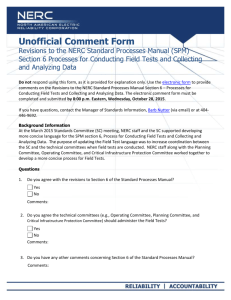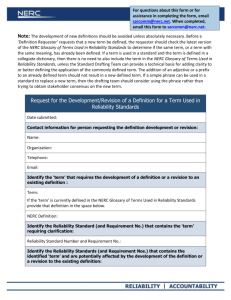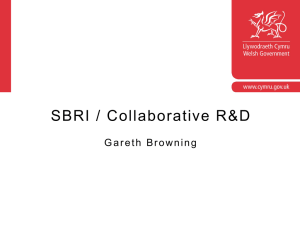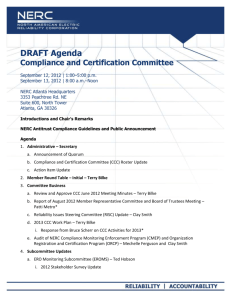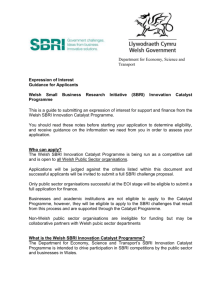Adaptive Autonomous Ocean Sampling Networks Project Brief
advertisement
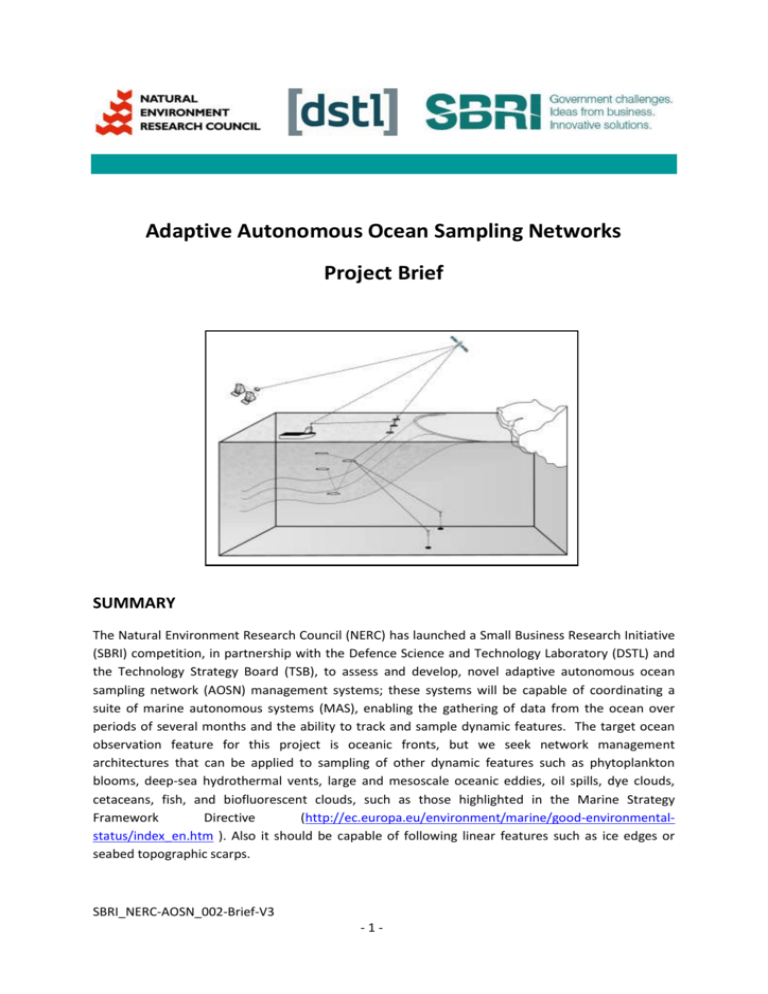
Adaptive Autonomous Ocean Sampling Networks Project Brief SUMMARY The Natural Environment Research Council (NERC) has launched a Small Business Research Initiative (SBRI) competition, in partnership with the Defence Science and Technology Laboratory (DSTL) and the Technology Strategy Board (TSB), to assess and develop, novel adaptive autonomous ocean sampling network (AOSN) management systems; these systems will be capable of coordinating a suite of marine autonomous systems (MAS), enabling the gathering of data from the ocean over periods of several months and the ability to track and sample dynamic features. The target ocean observation feature for this project is oceanic fronts, but we seek network management architectures that can be applied to sampling of other dynamic features such as phytoplankton blooms, deep-sea hydrothermal vents, large and mesoscale oceanic eddies, oil spills, dye clouds, cetaceans, fish, and biofluorescent clouds, such as those highlighted in the Marine Strategy Framework Directive (http://ec.europa.eu/environment/marine/good-environmentalstatus/index_en.htm ). Also it should be capable of following linear features such as ice edges or seabed topographic scarps. SBRI_NERC-AOSN_002-Brief-V3 -1- A wide range of low power sensors now exists to make the measurements, and appropriate satellite navigation tools are readily available. Satellite communications for command and control, and for data transfer to shore, are now routine. Furthermore, NERC’s new MAS capability will see vehicles deployed in the open ocean for periods of several months. NERC seeks applications to first assess the viability of rugged, robust and reliable solutions for an AOSN management system capable of coordinating a fleet of MAS. Competition criteria will consider the appropriateness of the technical approach, the degree of innovation, and how this is balanced against project risk, the technical and commercial viability, and the appropriateness of the financial and project management arrangements. The competition will run in two phases: Phase 1 will open on 2 September 2014 for feasibility studies, with contracts to be awarded, for those selected, in mid December 2014 and completed by 31 March 2015. This call will fund up to five Phase 1 studies up to a cost including VAT of £50,000 each. After reviewing the outcomes of the Phase 1 studies, selected participants will be invited to apply for Phase 2 for the development of prototypes, which would be capable of undertaking demonstration missions at sea. It is expected that phase 2 will be in the region of £1.2M and available for up to two selected projects. AN INTRODUCTION TO SBRI SBRI is a mechanism that enables public sector bodies to connect with innovative ideas and technology businesses to provide novel solutions to specific public sector challenges and needs. The public sector is able to find innovative solutions by reaching out to companies from different sectors, including small and emerging businesses. New technical solutions are created through accelerated technology development, whilst risk is reduced through a phased development programme. SBRI also provides business with a transparent, competitive, and reliable source of early‐stage funding. The SBRI scheme is particularly suited to small and medium‐sized business, as the contracts are of relatively small value and operate on short timescales. Developments are 100% funded and focused on specific identified needs, increasing the chance of exploitation. Suppliers for each project will be selected through an open competition process and retain the intellectual property generated from the project, with certain rights of use retained by the contracting public agency. This is an excellent opportunity to establish an early customer for a new technology and to fund its development. SBRI is championed by the Technology Strategy Board (TSB). For further details please visit the TSB website: www.innovateuk.org FUNDING BODIES The Natural Environment Research Council The Natural Environment Research Council (NERC) delivers independent research, survey, training and knowledge transfer in the environmental sciences, to advance knowledge of planet Earth as a complex, interacting system. The remit covers atmospheric, earth, biological, terrestrial and aquatic sciences, from the deep oceans to the upper atmosphere, and from the poles to the equator. SBRI_NERC-AOSN_002-Brief-V3 -2- NERC’s mission is to gather and apply knowledge, create understanding and predict the behaviour of the natural environment and its resources, and communicate all aspects of the science. The funding, administrative and corporate activities are run from offices in Swindon. NERC funds research in universities and in six research centres. The latter are owned by NERC and the staff working there are NERC employees. Several more centres around the country work in partnership with NERC to carry out research as needed. NERC provides high‐technology research facilities including research ships and aircraft, analytical facilities, satellite data processing, supercomputers and pools of specialist equipment. NERC have set up a series of data centres to hold and manage NERC data. As part of its strategy for national capability, NERC has identified the need to identify, develop and adapt new technologies for collecting environmental data. Predictive earth system models are undergoing a step change in capability, driven by both advances in computational technologies and by improved knowledge of the processes and interactions in the real world and their simulation within the models. However, predictive models need real data to provide the initial conditions and to ensure the outputs of the models represent reality. The Technology Strategy Board The Technology Strategy Board (TSB) is the UK’s innovation agency. Its goal is to accelerate economic growth by stimulating and supporting business‐led innovation. Sponsored by the Department for Business, Innovation and Skills (BIS), the TSB brings together business, research and the public sector, supporting and accelerating the development of innovative products and services to meet market needs, tackle major societal challenges and help build the future economy. The Defence Science and Technology Laboratory Dstl is the UK government’s in-house defence science and technology (S&T) organisation, working with industry, academia and international partners to deploy and deliver advances in military capability, support government decision-making and insure against current and future threats and risks. Dstl provides professional in-house expertise and leads the defence and security S&T community to develop and employ the capabilities needed to implement the National Security Strategy and the Strategic Defence and Security Review. The mission of Dstl is to maximise the impact of science and technology for the defence and security of the UK. This includes research, advice, consultancy, technical and systems risk management and related activities as well as social science, mathematics and engineering. As part of its work to deliver advances in military capability within the maritime environment, Dstl has identified unmanned surface vehicles and other unmanned platforms as having the potential to support the delivery of a range of military capabilities. In several areas the speed, endurance and persistence of current autonomous systems limits the scope of tasks that could be provided by future unmanned platforms, hence our interest in new concepts for long endurance unmanned surface vehicles. SBRI_NERC-AOSN_002-Brief-V3 -3- BACKGROUND AND CHALLENGE The concept of AOSN was introduced two decades ago1 but to date there are very few AOSNs in operation. The AOSN concept leverages MAS and dynamic models to observe and predict dynamic ocean fields. Several experiments have been carried out in the USA2 and Europe to demonstrate the feasibility of these systems. The implementation of persistent AOSN has been hindered by the uncertainty in the environment and financial consequences of loss. With the increased availability of high-resolution ocean models and increased reliability of autonomous underwater vehicles, it is now feasible to develop and integrate software based system architectures to implement and manage AOSN. New and novel network management approaches for coordinating an AOSN, consisting of NERC’s suite of Autonomous Surface Vehicles (ASVs), are sought. We encourage new and fresh lines of thought: ideas that bring technologies to bear from outside the marine sector, and ideas that exploit other instruments and platforms that are used by NERC such as seabed landers, autonomous underwater vehicles and submarine gliders. The proposed network management architecture should be modular and scalable to different configurations. We seek solutions that will enable NERC ASVs to detect and track an oceanic front, marked by sharp changes in temperature, density and biological communities. A network management system that allows the specification of a formation of ASVs is welcomed. We encourage solutions that can be applied to track other dynamic features as outlined above. In 2014 the NERC ASV fleet comprises of several types of vehicles, including Liquid Robotics Wavegliders, ASV C-Enduro and MOST Autonaut. These vehicles meet different specifications but as an example they will have a cruise speed between 2.5-4.0 knots in sea state 3, a maximum payload of 30 kgs and a mast with a height between 2-2.6m. All vehicles have an autopilot and mission management systems, details of which can be provided upon request. In Phase 1, the applicants should provide details concerning systems and methods for data communications and management. We would welcome solutions that will enable the transfer images.. Details of the models proposed for supporting AOSN decision-making should be defined and tested in a simulation environment. For the purpose of Phase 1 the indicative mission endurance is to be 15 days. The concept is to deploy a suite of MAS to detect and track a dynamic feature, whilst maintaining a specific formation. A list of testing scenarios required in Phase 2 is presented in Table 1. Recognising the critical importance of providing sufficient energy for propulsion, solutions that obtain the optimum path for each scenario are encouraged. How the applicants intend to provide the AOSN management system with appropriate command and control capability should be described. To enable the reliability quantification of the proposed solution the adaptive behaviour of AOSN must be captured, e.g. in a state flow diagram. Given that 1 http://citeseerx.ist.psu.edu/viewdoc/download?doi=10.1.1.125.2514&rep=rep1&type=pdf Curtin T., Bellingham, B.G. Progress toward autonomous ocean sampling networks. Deep-Sea Research II (56), 62-67, 2009. 2 SBRI_NERC-AOSN_002-Brief-V3 -4- the vehicles will need to operate outside of shore‐based cellular phone systems, we expect applicants to provide details of the robustness of the communication systems. Table 1. List of Phase 2 scenarios. Scenarios of interest 1. Cetacean tracking. 2. Follow a tidal-mixing front, separating tidally mixed and seasonally stratified shelf waters, each with markedly different physical properties. Test strategy and deliverables Marine Autonomous Systems Follow a target MAS, equipped with an active sonar ping mimicking cetacean clicks. Surface vehicles (C-Enduro, Autonaut or wave gliders), underwater gliders and Autosub Long Range, or other commercially available Track the target front, to vehicles (Gavia, Remus, Hugin, ensure maximum etc.) number of front crossings (surface and subsurface) across a broad area. 3. Identify source of a single To be simulated by a dye point leak, such as a surface release. oil spill. 4. Tagged fish tracking Record tagged fish within a discrete area, potentially in combination with a seafloor transponder array. 5. Seabed swath mapping Follow and map a prominent topographic feature, e.g. canyon wall, rocky reef. For phase 2, for scenarios 1 to 3, the sea trials are envisaged to take place off the coast of the Scilly Isles. For scenarios 4 to 5, the sea trials are envisaged to take place off the coast of Plymouth. These tests will be supported using NERC’s National Marine Facilities Equipment. A number of sensors will be made available for the demonstration phase. The list of sensors is presented in Annex A of the brief, document reference SBRI_NERC-AOSN_002-Brief_ AnnexA-V3. SBRI_NERC-AOSN_002-Brief-V3 -5- SBRI_NERC-AOSN_002-Brief-V3 -6- SCOPE The competition is open to any eligible organisation that can demonstrate a route to market. Collaboration is encouraged; the emphasis should be on innovation and rapid demonstration of new capability. Consequently, Phase 1 can include tangible results of experiments or trials, and should not be just a desk study. APPLICATION PROCESS Interested companies can find full details of the application process at http://www.noc.ac.uk/sbri Bids should be made using the Application Form, which can also be accessed from http://www.noc.ac.uk/sbri . Queries can be sent to sbri‐noc@noc.ac.uk . KEY DATES Phase 1 (design/feasibility study) Competition Launch 2 September 2014 Deadline for applications Noon on 31 October 2014 Assessment 20 November 2014 Applicants notified of decision 25 November 2014 Phase 1 Contracts awarded mid December 2014 Phase 1 Contracts to end 31 March 2015 SBRI_NERC-AOSN_002-Brief-V3 -7-


